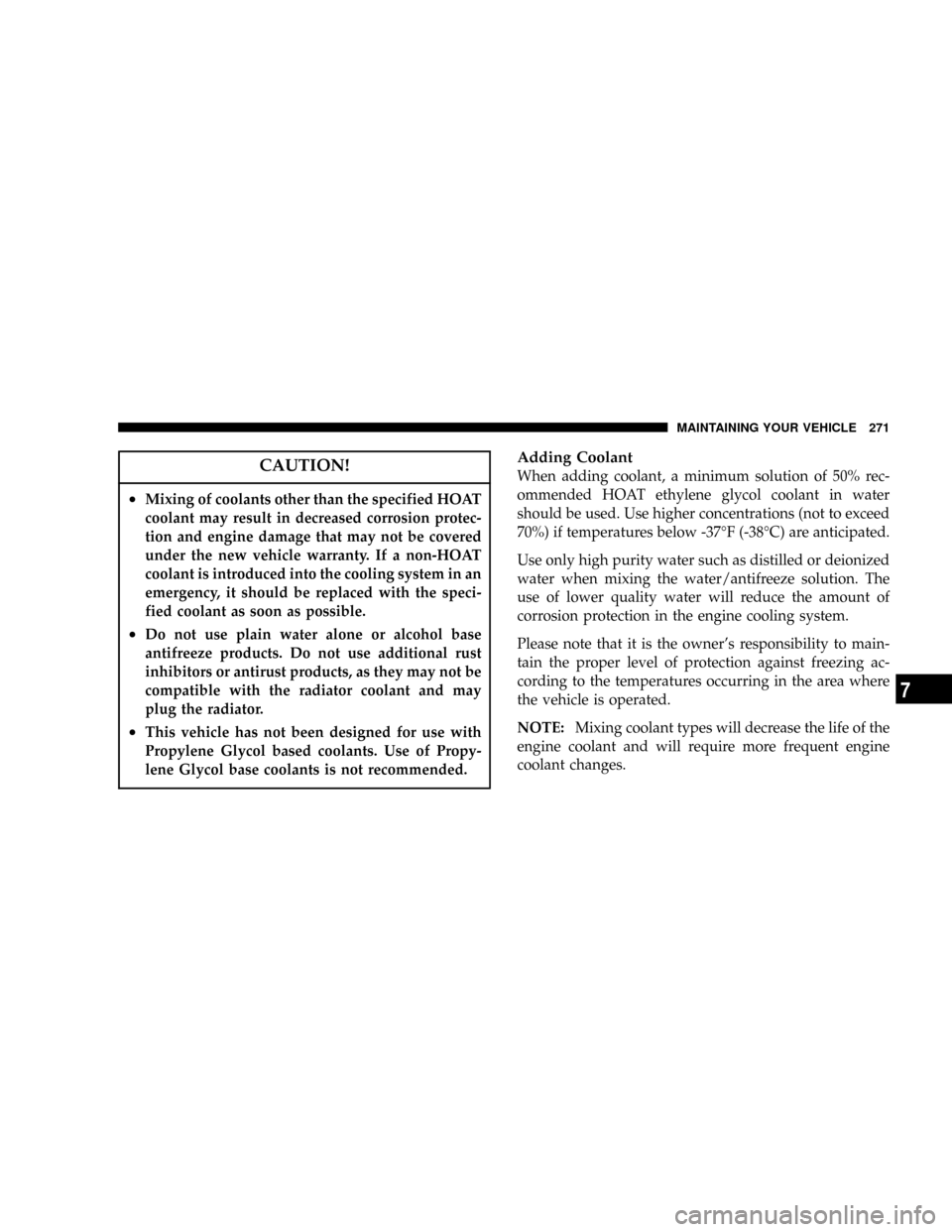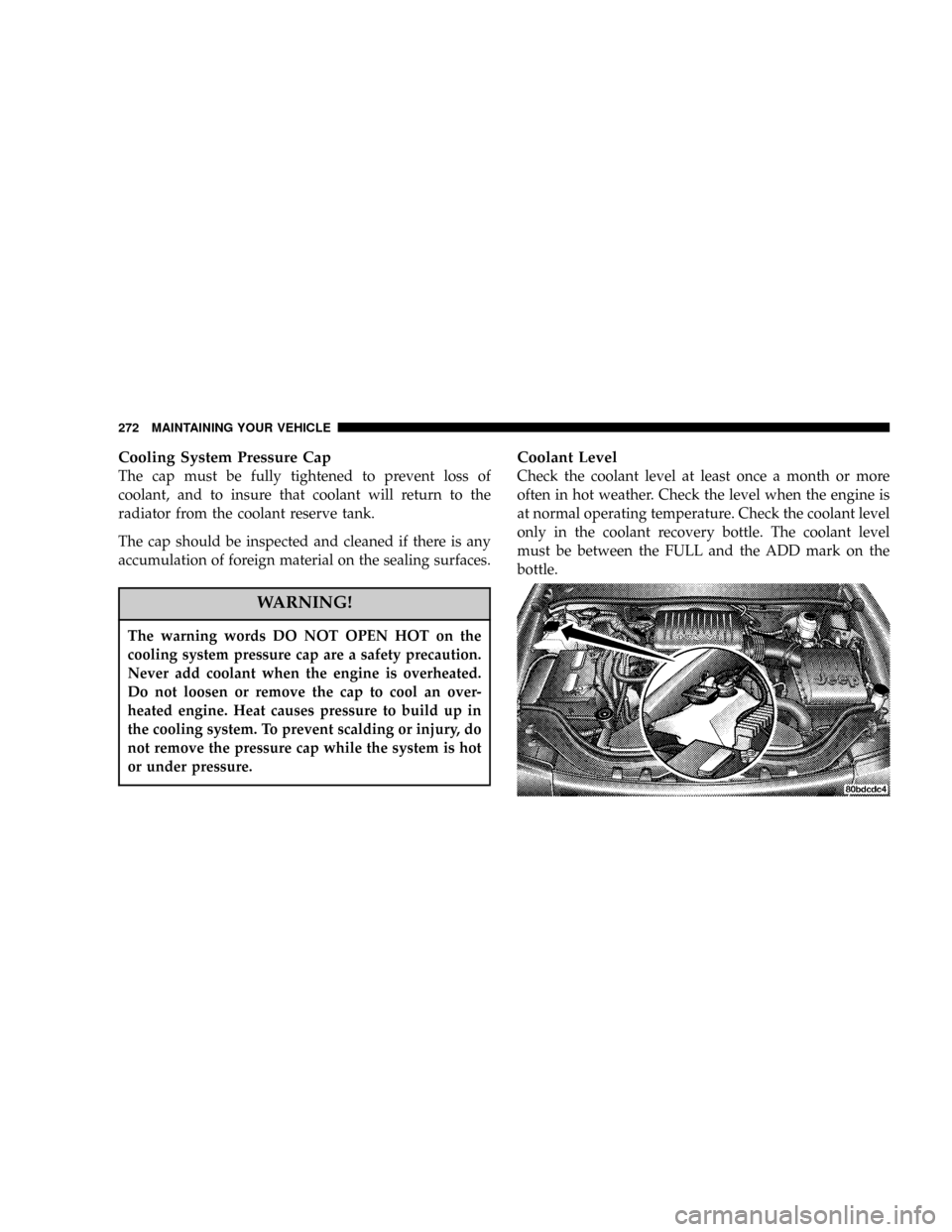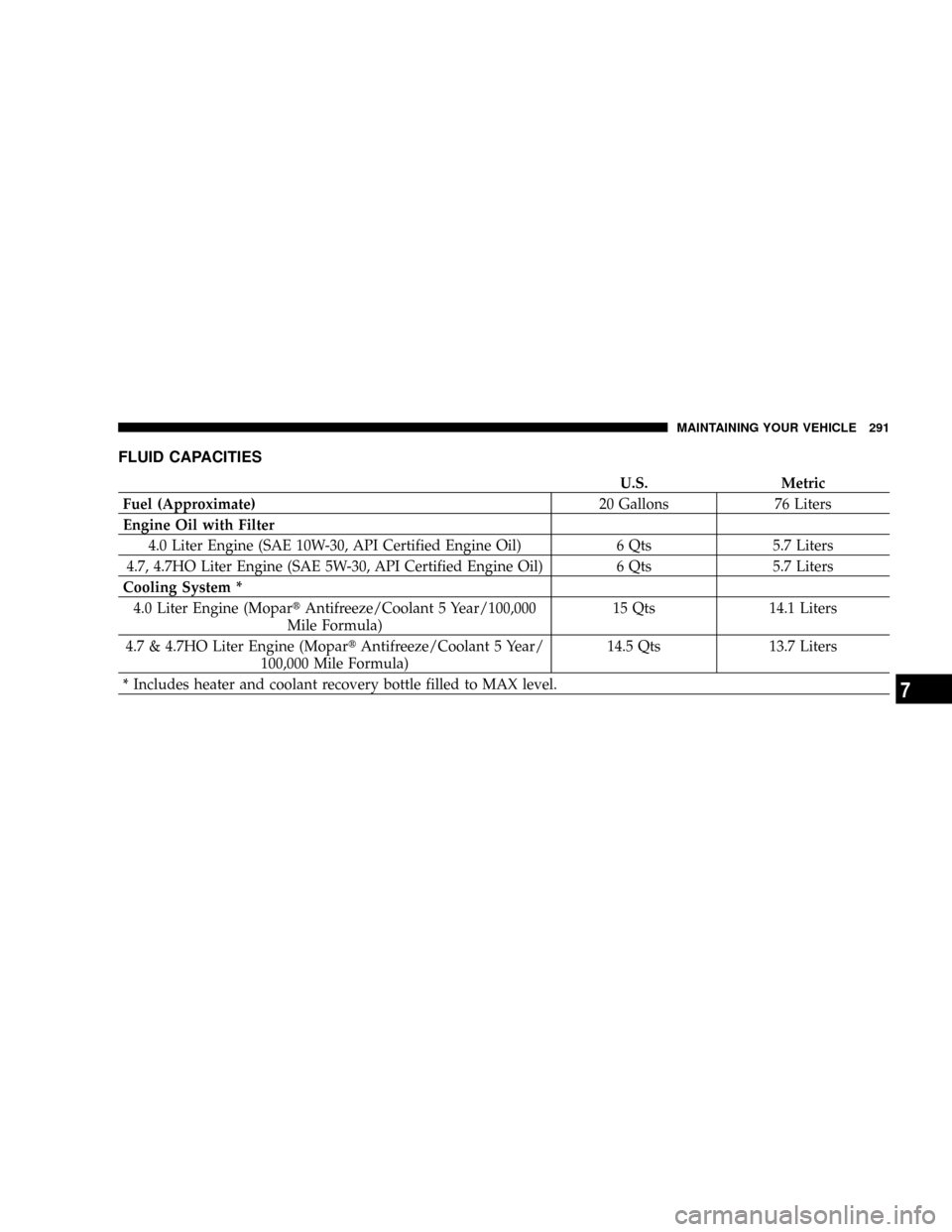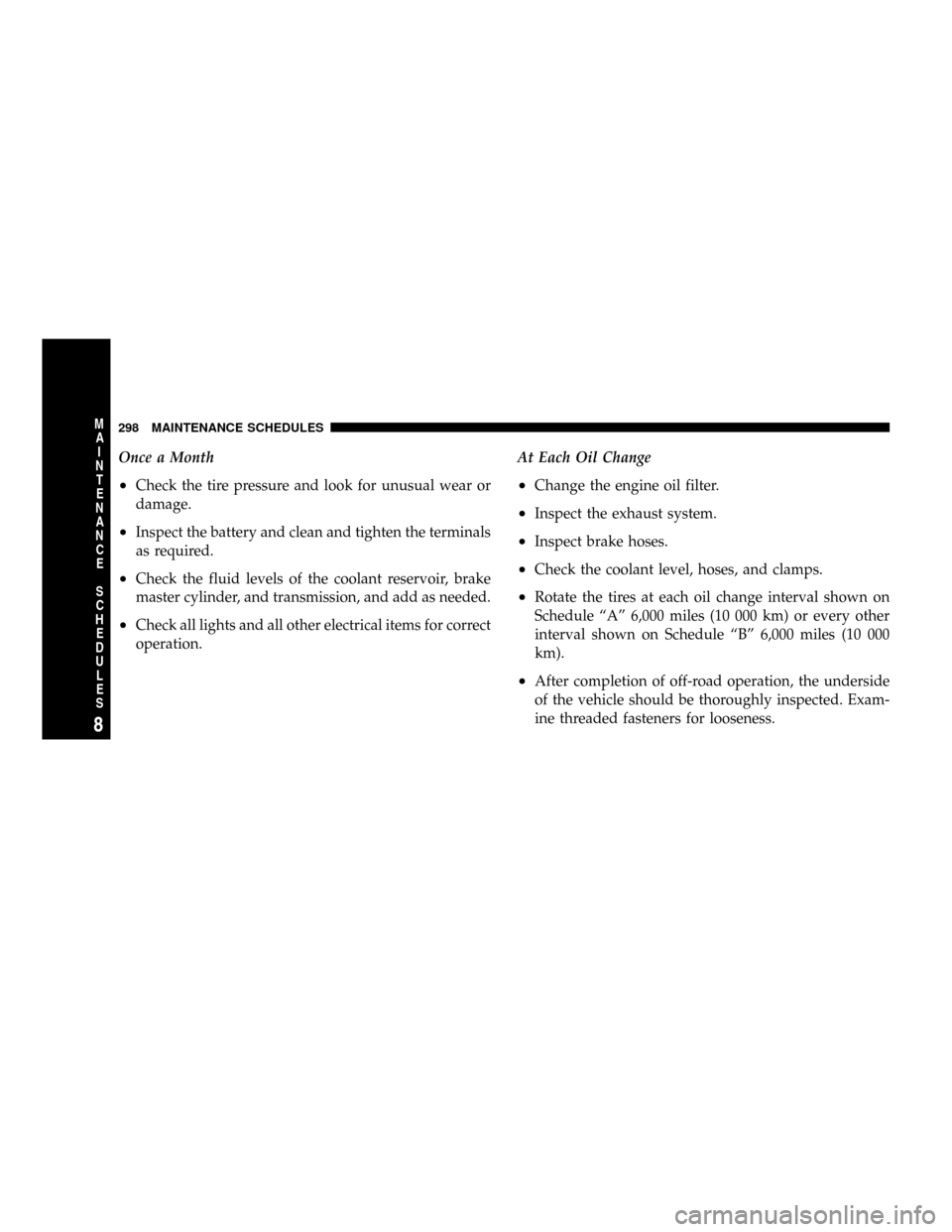coolant level JEEP GRAND CHEROKEE 2004 WK / 3.G Owners Manual
[x] Cancel search | Manufacturer: JEEP, Model Year: 2004, Model line: GRAND CHEROKEE, Model: JEEP GRAND CHEROKEE 2004 WK / 3.GPages: 344, PDF Size: 6.09 MB
Page 271 of 344

CAUTION!
²Mixing of coolants other than the specified HOAT
coolant may result in decreased corrosion protec-
tion and engine damage that may not be covered
under the new vehicle warranty. If a non-HOAT
coolant is introduced into the cooling system in an
emergency, it should be replaced with the speci-
fied coolant as soon as possible.
²Do not use plain water alone or alcohol base
antifreeze products. Do not use additional rust
inhibitors or antirust products, as they may not be
compatible with the radiator coolant and may
plug the radiator.
²This vehicle has not been designed for use with
Propylene Glycol based coolants. Use of Propy-
lene Glycol base coolants is not recommended.
Adding Coolant
When adding coolant, a minimum solution of 50% rec-
ommended HOAT ethylene glycol coolant in water
should be used. Use higher concentrations (not to exceed
70%) if temperatures below -37ÉF (-38ÉC) are anticipated.
Use only high purity water such as distilled or deionized
water when mixing the water/antifreeze solution. The
use of lower quality water will reduce the amount of
corrosion protection in the engine cooling system.
Please note that it is the owner's responsibility to main-
tain the proper level of protection against freezing ac-
cording to the temperatures occurring in the area where
the vehicle is operated.
NOTE:Mixing coolant types will decrease the life of the
engine coolant and will require more frequent engine
coolant changes.
MAINTAINING YOUR VEHICLE 271
7
Page 272 of 344

Cooling System Pressure Cap
The cap must be fully tightened to prevent loss of
coolant, and to insure that coolant will return to the
radiator from the coolant reserve tank.
The cap should be inspected and cleaned if there is any
accumulation of foreign material on the sealing surfaces.
WARNING!
The warning words DO NOT OPEN HOT on the
cooling system pressure cap are a safety precaution.
Never add coolant when the engine is overheated.
Do not loosen or remove the cap to cool an over-
heated engine. Heat causes pressure to build up in
the cooling system. To prevent scalding or injury, do
not remove the pressure cap while the system is hot
or under pressure.
Coolant Level
Check the coolant level at least once a month or more
often in hot weather. Check the level when the engine is
at normal operating temperature. Check the coolant level
only in the coolant recovery bottle. The coolant level
must be between the FULL and the ADD mark on the
bottle.
272 MAINTAINING YOUR VEHICLE
Page 273 of 344

See your authorized dealer if the coolant level drops
quickly.
Points To Remember
NOTE:When the vehicle is stopped after a few miles of
operation, you may observe vapor coming from the front
of the engine compartment. This is normally a result of
moisture from rain, snow, or high humidity accumulat-
ing on the radiator and being vaporized when the
thermostat opens, allowing hot coolant to enter the
radiator.
If an examination of your engine compartment shows no
evidence of radiator or hose leaks, the vehicle may be
safely driven. The vapor will soon dissipate.
²Do not overfill the coolant bottle.
²Check coolant freeze point in the system.
²If frequent coolant additions are required, or if the
level in the recovery bottle does not drop when the
engine cools, the cooling system should be pressure
tested for leaks.
²Maintain coolant concentration at 50% ethylene glycol
antifreeze (minimum) in water for proper corrosion
protection of your engine that contains aluminum
components.
²Make sure that the radiator and coolant bottle hoses
are not kinked or obstructed.
²Do not change the thermostat for summer or winter
operation. If replacement is ever necessary, install
ONLY the correct type thermostat. Other designs may
result in unsatisfactory cooling performance, poor gas
mileage, and increased emissions.
MAINTAINING YOUR VEHICLE 273
7
Page 291 of 344

FLUID CAPACITIES
U.S. Metric
Fuel (Approximate)20 Gallons 76 Liters
Engine Oil with Filter
4.0 Liter Engine (SAE 10W-30, API Certified Engine Oil) 6 Qts 5.7 Liters
4.7, 4.7HO Liter Engine (SAE 5W-30, API Certified Engine Oil) 6 Qts 5.7 Liters
Cooling System *
4.0 Liter Engine (MopartAntifreeze/Coolant 5 Year/100,000
Mile Formula)15 Qts 14.1 Liters
4.7 & 4.7HO Liter Engine (MopartAntifreeze/Coolant 5 Year/
100,000 Mile Formula)14.5 Qts 13.7 Liters
* Includes heater and coolant recovery bottle filled to MAX level.
MAINTAINING YOUR VEHICLE 291
7
Page 298 of 344

Once a Month
²Check the tire pressure and look for unusual wear or
damage.
²Inspect the battery and clean and tighten the terminals
as required.
²Check the fluid levels of the coolant reservoir, brake
master cylinder, and transmission, and add as needed.
²Check all lights and all other electrical items for correct
operation.At Each Oil Change
²Change the engine oil filter.
²Inspect the exhaust system.
²Inspect brake hoses.
²Check the coolant level, hoses, and clamps.
²Rotate the tires at each oil change interval shown on
Schedule ªAº 6,000 miles (10 000 km) or every other
interval shown on Schedule ªBº 6,000 miles (10 000
km).
²After completion of off-road operation, the underside
of the vehicle should be thoroughly inspected. Exam-
ine threaded fasteners for looseness.
298 MAINTENANCE SCHEDULES
8
M
A
I
N
T
E
N
A
N
C
E
S
C
H
E
D
U
L
E
S
Page 328 of 344

Adding Washer Fluid..................... 171
Adjustable Pedals........................ 84
Air Cleaner, Engine...................... 264
Air Conditioner Maintenance............... 265
Air Conditioning........................ 164
Air Conditioning Refrigerant............... 266
Air Conditioning System.................. 164
Air Filter.............................. 264
Air Pressure, Tires....................... 212
Airbag................................ 35
Airbag Deployment....................... 42
Airbag Light.......................44,52,129
Airbag Maintenance....................... 43
Alarm................................ 23
Alarm, Panic............................ 21
Alarm System........................... 23
Alignment and Balance................... 217
Alterations/Modifications, Vehicle............. 8
Antenna, Satellite Radio................... 155Antifreeze (Engine Coolant)................ 291
Anti-Lock Brake System................... 197
Anti-Lock Warning Light.................. 133
Anti-Theft System........................ 23
Appearance Care........................ 281
Arming Theft System...................... 23
Automatic Dimming Mirror................. 60
Automatic Door Locks..................... 19
Automatic Headlights..................... 77
Automatic Temperature Control............. 167
Automatic Transmission................179,277
Adding Fluid......................278,279
Fluid and Filter Changes................. 277
Fluid Level Check...................277,278
Fluid Type........................... 277
Gear Ranges.......................... 181
Overdrive........................... 182
Shifting............................. 179
Special Additives...................... 280
328 INDEX
Page 330 of 344

Cassette Tape and Player Maintenance......... 162
Cassette Tape Player...................143,147
Catalytic Converter...................... 261
Caution, Exhaust Gas...................... 51
CD Changer......................140,150,156
CD Player....................136,139,143,149
CD Player Maintenance................... 163
Cellular Phone.......................... 164
Center Lap Belts......................... 33
Chains, Tire............................ 220
Chart, Tire Sizing........................ 204
Check Engine Light...................... 130
Checks, Safety.........................52,53
Child Restraint.......................... 44
Child Restraint Tether Anchors............... 47
Child Safety Locks........................ 18
Climate Control......................... 164
Clock................................ 135
Compact Disc Maintenance................. 163Compact Spare Tire...................... 241
Compass...........................101,104
Compass Calibration..................... 104
Compass Variance....................... 105
Computer, Trip/Travel.................... 101
Console, Overhead....................... 89
Contract, Service........................ 320
Converter, Catalytic...................... 261
Cooling System......................... 269
Adding Coolant (Antifreeze).............. 271
Coolant Capacity...................... 291
Coolant Level......................... 272
Disposal of Used Coolant................ 270
Drain, Flush, and Refill.................. 270
Inspection........................... 269
Points to Remember.................... 273
Pressure Cap......................... 272
Radiator Cap......................... 272
Selection of Coolant..................270,291
330 INDEX